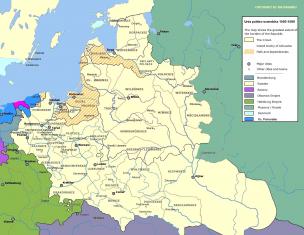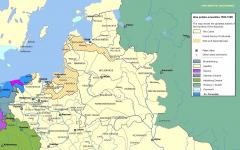Tutorial for students of pedagogical institutes. - 2nd ed., revised. - M.: Education, 1986. - 223 pp. The manual reveals theoretical and practical questions training German language V high school taking into account the latest provisions of modern teaching methods. The manual is intended for students of pedagogical universities and teachers of the German language. Table of contents:
Preface.
Part. Scientific and theoretical foundations of teaching methods foreign languages in middle school.
Chapter. Methods of teaching foreign languages as a pedagogical science.
Scientific foundations of methods of teaching foreign languages.
Research methods in teaching foreign languages.
Basic methodological categories and concepts.
Chapter. Linguistic and psychological foundations of teaching foreign languages in secondary school.
Linguistic and psychological characteristics of speech activity.
Linguopsychological characteristics of communication skills and speech skills.
Chapter. Linguistic foundations of teaching a foreign language.
The dichotomy “language - speech” and methodological conclusions from it.
Communicative organization of linguistic material.
Chapter. Didactics - methodological foundations of teaching foreign languages in secondary school.
Didactic and methodological principles for the formation of a communist worldview and general development students in teaching a foreign language.
Didactic and “technological” principles of teaching foreign languages.
Chapter. Goals, content and means of teaching a foreign language in secondary school.
Goals of teaching foreign languages in secondary school.
Contents of teaching a foreign language.
Means of teaching a foreign language.
Part. Education communication skills and speech skills in German in high school.
Chapter. Communication skills training.
Chapter. Typology of exercises and their organization for communicative teaching of a foreign language.
Basic types and types of exercises.
A system of exercises for teaching a foreign language.
Chapter. Teaching the ability to understand spoken language in German in high school.
Linguistic and psychological characteristics of listening as a type of speech activity.
Teaching listening comprehension in German in secondary school.
Chapter. Teaching dialogical speech skills in German in high school.
Linguistic and psychological characteristics of dialogical communication.
Training in dialogical communication skills.
Chapter. Skill training monologue speech in German in high school.
Linguistic and psychological characteristics of monologue speech.
Teaching monologue speech in German in high school.
Chapter. Teaching reading skills in German in high school.
Linguistic and psychological characteristics of reading as a type of speech activity.
Teaching reading skills in a foreign language about high school.
Teaching a complete and accurate understanding of a foreign text in high school.
Chapter. Teaching writing and writing in German in high school.
Psychological characteristics of written speech.
Writing as a means of communication.
Communicative writing.
Chapter. Teaching German language skills in high school.
Chapter. Teaching German phonetic skills in high school.
A brief comparative description of the sounds of German and Russian languages.
Teaching German phonetic skills in high school.
Chapter. Teaching German grammar skills in high school.
Linguopsychological characteristics of grammatical skills of the German language.
Requirements for the volume and selection of grammatical material in the German language for secondary school.
Teaching grammatical skills of speaking and writing in German.
Teaching receptive grammar skills.
Chapter. Teaching German lexical skills in high school.
Linguistic and psychological characteristics of lexical skills.
Volume, criteria for selecting vocabulary and its typology.
Teaching vocabulary skills in middle school.
Part. Organization of the process of teaching German in secondary school.
Chapter. The initial stage of teaching a foreign language (grades IV-V).
General characteristics of the initial stage of teaching a foreign language.
Introductory course in IV grade.
Contents and teaching methods at the initial stage (grades IV-V).
Chapter. The middle stage of learning the German language (grades VI-VII).
General characteristics of the middle stage of learning a foreign language.
Contents of teaching a foreign language at the middle stage.
Basic methodological provisions.
Chapter. The final stage of teaching German in secondary school (grades VIII-X).
General characteristics of the senior stage of learning the German language.
Goals, conditions and content of teaching foreign languages at the final stage.
Basic methodological principles of teaching a foreign language at the senior stage.
Chapter. Control of skills and abilities of practical knowledge of a foreign language.
Functions of control in foreign language lessons and requirements for its implementation.
Objects of control.
Types and forms of control.
Chapter. Planning the process of teaching German in secondary school.
Goals and types of planning.
Thematic planning.
Planning goals and main components of lessons in the system.
Chapter. Optional foreign language course.
Goals, objectives and organizational forms of conducting an elective course.
The main stages and some issues of the methodology of teaching a foreign language in elective classes.
Chapter. Extracurricular and extracurricular work in a foreign language.
Goals and objectives of extracurricular and extracurricular activities.
Requirements for extracurricular and extracurricular work.
Forms of extracurricular and extracurricular activities.
Part. Short review history of methods of teaching foreign languages in secondary schools.
Chapter. Translation methods of teaching foreign languages.
Transfer method in the history of foreign methods.
Translation methods of teaching foreign languages in Russia.
Chapter. Direct method of teaching foreign languages.
Direct method in the West.
Direct methods in Russia.
Chapter. Mixed methods of teaching foreign languages.
Mixed methods in the West.
Mixed method of teaching a foreign language about Russia.
Chapter. The main stages in the development of Soviet methods of teaching foreign languages.
The first stage of development of the Soviet methodology (1924-1930).
The second stage of development of the Soviet methodology (1931-1944).
The third stage in the development of Soviet methodology (1944-1961).
The current stage of development of methods of teaching foreign languages.
Literature.
Passov E.I. Foreign language lesson in secondary school / E.I. Passov. - M.: Education, 1988.
Korostelev V. S. Principles of creating a system of communicative teaching of foreign language culture / V. S. Korostelev, E. I. Passov, V. P. Kuzovlev // Foreign languages at school. - 1988. - No. 2.
Method of activating the capabilities of the individual and the team of A. Kitaygorodskaya
Kitaigorodskaya G. A. Methods of intensive teaching of foreign languages / G. A. Kitaigorodskaya.
Kitaigorodskaya G. A.- M.: Higher School, 1982. A. Methodological foundations of intensive teaching of foreign languages / G.
Kitaigorodskaya.
- M.: MSU, 1986.
Methodological concept p. F. Shatilova
Shatilov S. F. Methods of teaching the German language in secondary school / S. F. Shatilov. - M.: Education, 1986.
Shatilov S. F. Optional course of the German language: for students of the 8th grade of secondary school / S. F. Shatilov. - M.: Education, 1980. Methodological concept of P. B. Gurvich Gurvich P. Methodological concept of P. B. Gurvich B.
Shatilov S. F. Optional course of the German language: for students of the 8th grade of secondary school / S. F. Shatilov. - M.: Education, 1980. Methodological concept of P. B. Gurvich Theory and practice of experiment in the methodology of teaching foreign languages (special course) / P. Methodological concept of P. B. Gurvich Gurvich.
- Vladimir, 1980. Basics of training oral speech
at language departments. Part 1. - Vladimir, 1972; Part 2. - Vladimir, 1974.
LITERATURE
Shatilov S. F. Methods of teaching the German language in secondary school / S. F. Shatilov. - M.: Education, 1986. - P. 179-181, 188-212.
Mirolyubov A. A. History of domestic methods of teaching foreign languages / A. A. Mirolyubov. - M.: Steps, INFRA-M, 2002. - Sec. V. - pp. 269-286; Sec. VI. - P. 339-372.
Gez N. I. Methods of teaching foreign languages in secondary school / N. I. Gez, M. V. Lyakhovitsky, A. A. Mirolyubov, etc. - M.: Higher school, 1982. - P. 113-114, 139 -155.
Theory and methodology of teaching foreign languages.
Reader. Textbook allowance. In 2 parts. Part 1 / comp.: A. V. Bolshakova, E. F. Ivanova, N. P. Serebryakova and others; under general ed. N.V. Yazykova. - Ulan-Ude: Buryat State University Publishing House, 2008.
To narrow down the search results, you can refine your query by specifying the fields to search for. The list of fields is presented above. For example:
You can search in several fields at the same time: Logical operators.
The default operator is Logical operators AND
Operator
means that the document must match all elements in the group: research development Operator
OR research development means that the document must match one of the values in the group:
means that the document must match all elements in the group: study development
OR study means that the document must match one of the values in the group:
NOT
excludes documents containing this element:
Search type
When writing a query, you can specify the method in which the phrase will be searched. Four methods are supported: search taking into account morphology, without morphology, prefix search, phrase search.
$ OR $ By default, the search is performed taking into account morphology.
To search without morphology, just put a “dollar” sign in front of the words in the phrase:
development *
To search for a prefix, you need to put an asterisk after the query:
" study "
To search for a phrase, you need to enclose the query in double quotes:
research and development #
Search by synonyms
To include synonyms of a word in the search results, you need to put a hash "
" before a word or before an expression in parentheses.
When applied to one word, up to three synonyms will be found for it.
# development
When applied to a parenthetical expression, a synonym will be added to each word if one was found.
Not compatible with morphology-free search, prefix search, or phrase search.
For example, you need to make a request: find documents whose author is Ivanov or Petrov, and the title contains the words research or development:
Approximate word search
For an approximate search you need to put a tilde " ~ " at the end of a word from a phrase. For example:
bromine ~
When searching, words such as "bromine", "rum", "industrial", etc. will be found.
You can additionally specify the maximum number of possible edits: 0, 1 or 2. For example:
bromine ~1
By default, 2 edits are allowed.
Proximity criterion
To search by proximity criterion, you need to put a tilde " ~ " at the end of the phrase. For example, to find documents with the words research and development within 2 words, use the following query:
" Operator "~2
Relevance of expressions
To change the relevance of individual expressions in the search, use the " sign ^
" at the end of the expression, followed by the level of relevance of this expression in relation to the others.
The higher the level, the more relevant the expression is.
For example, in this expression, the word “research” is four times more relevant than the word “development”:
development ^4 means that the document must match one of the values in the group:
By default, the level is 1. Valid values are a positive real number.
Search within an interval
To indicate the interval in which the value of a field should be located, you should indicate the boundary values in parentheses, separated by the operator TO.
Lexicographic sorting will be performed.
Such a query will return results with an author starting from Ivanov and ending with Petrov, but Ivanov and Petrov will not be included in the result.
To include a value in a range, use square brackets. To exclude a value, use curly braces.









